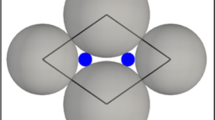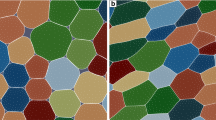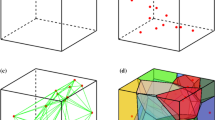Abstract
A discrete element simulation of a mechanical problem involving granular materials begins with the definition of the geometry of the sample to be analyzed. Since the dynamic sample preparation methods typically used in the practice are very time-consuming, constructive algorithms are becoming increasingly popular. This paper introduces a novel constructive method for the preparation of random, isotropic assemblies of contacting circular discs with a user-defined grain size distribution. The proposed approach is compared with other currently applied sample preparation methods.
Similar content being viewed by others
References
Saeid, S., Franke, C. (ed.): Procs International Workshop on the Rock Mechanics of Nuclear Waste Repositories. (Vail, Colorado, June 1999) Alexandria, Virginia: American Rock Mechanics Association (1999)
Konietzky, H. (ed).: Numerical Modeling in Micromechanics via Particle Methods. (Procs 1st International PFC Symposium, Gelsenkirchen, Germay 2002), Rotterdam, Balkema (2002)
Foo, Y.Y., Sheng, Y., Briscoe, B.J.: An experimental and numerical study of the compaction of alumina aggregates. Int. J. Solids and Structures 41(21), 5929–5943 (2004)
Hopkins, M.A., Daly, S.F., Lever, J.H.: Three-dimensional simulation of river ice jams. In: Procs 8th International Specialty Conference on Cold Regions Engineering, Fairbanks, AK, August 1996, pp. 12–17
Hopkins, M.A.: Onshore Ice Pile-up: A Comparison between Experiments and Simulations. J. Cold Regions Science and Technology 26, 205–214 (1997)
Csepella, D., Vida, J., Bagi, K., Bojtár, I.: The interaction between blood flow and vessel wall. In: Bojtár, I. (ed.): Procs. Ist Hungarian Conference on Biomechanics, 11–12 June 2004, Budapest, Hungary, 2004, pp. 59–63
Helbing, D., Farkas, I., Vicsek, T.: Simulating dynamical features of escape panic. Nature 407(28), 487–490 (2000)
Cundall, P.A. – Strack, O.D.L.: A discrete numerical model for granular assemblies. Geotechnique 29(1), 47–65 (1979)
Cundall, P.A.: Computer simulation of dense sphere assemblies. In: Satake, M., Jenkins, J.T. (eds.): Micro-mechanics of Granular Materials, Elsevier (1988), pp. 113–123
Kuhn, M.R.: A smooth convex three-dimensional particle for the Discrete Element Method. J. Eng Mech. 129(5), 539–547 (2003)
Ting, J.M., Khwaja, M., Meachum, L.R., Rowell, J.D.: An Ellipse-based Discrete Element Model for Granular Materials. Int. J. for Numerical and Analytical Methods in Geomechanics 17(9), 603–623 (1993)
Serrano, A.A., Rodriguez-Ortiz, J.M.: A contribution to the mechanics of heterogeneous granular media. In: Procs. Symp. Plasticity and Soil Mechanics 1973, pp. 215–227
Bagi, K.: A quasi-static numerical model for micro-level analysis of granular assemblies. Mechanics of Materials 16(1–2), 101–110 (1993)
Kishino, Y.: Disc model analysis of granular media. In: Satake, M., Jenkins, J.T. (eds.): Micromechanics of Granular Materials, Elsevier 1988, pp. 143–152
Zhuang, X., Didwania, A.K., Goddard, J.D.: Simulation of the quasi-static mechanics and scalar transport properties of ideal granular assemblages. J. Comput. Phys. 121(2), 331–346 (1995)
Bojtár, I.: Numerical analysis of the microstructure of granular media. Építés- és Építészettudomány 1–2, 75–93, in Hungarian (1989)
Bagi, K.: From order to chaos: The mechanical behaviour of regular and irregular assemblies. In: Bagi, K. (ed): Procs. QuaDPM’03 Workshop, 25–28 August 2003, Budapest, Hungary 2003, pp. 33–42
Feng, Y.T., Owen, D.R.J.: Filling domains with disks: an advancing front approach. Int. J. Numer. Meth. Engng 56, 699–713 (2003)
Cui, L., O’Sullivan, C.: Analysis of a triangulation based approach for specimen generation for discrete element simulations. Granular Matter 5(3), 135–145 (2003)
Stoyan, D.: Models of random systems of non-intersecting spheres, In: Prague Stochastics’98, JCMF 1998, pp. 543–547
Stoyan, D.: Random systems of hard particles: Models and statistics, Chinese Journal of Stereology and Image Analysis 7(1), 1–13 (2002)
Häggström, O., Meester, R.: Nearest neighbour and hard sphere models in continuum percolation. Random Struct. Algor. 9, 295–315 (1996)
Evans, J.W.: Random and cooperative sequential adsorption. Rev. Mod. Phys. 65, 1281–1304 (1993)
Döge, G.: Perfect simulation for random sequential adsorption of d dimensional spheres with random radii. J. Statist. Comput. Simul. 69, 141–156 (2001)
Particle Flow Code in 2 Dimensions. Itasca, Thresher Square East, 708 South Third Street 310, Minneapolis, Minnesota 55415 USA (2002)
Particle Flow Code in 3 Dimensions. Itasca, Mill Place, 111 Third Avenue South, 450, Minneapolis, Minnesota 55401 USA (2003)
Metropolis, N., Rosenbluth, A.W., Rosenbluth, M.N., Teller, A.H., Teller, E.: Equations of state calculations by fast computing machines. J. Chem. Phys. 21, 1087–1092 (1953)
Hastings, W.K.: Monte Carlo sampling methods using Markov chains and their applications. Biometrica 57, 97–109 (1970)
Mase, S., Moller, J., Stoyan, D., Waagepeterse, R.P. Döge, G.: Packing densities and simulated tempering for hard core Gibbs point processes. Ann. Inst. Statist. Math. 53, 661–680 (2001)
Torquato, S.: Random heterogeneous materials. Springer-Verlag, New York (2002), see p. 275
Jodrey, W.S., Tory, E.M.: Simulation of close random packing of spheres. J. Simulation 32, 1–12 (1979)
Jodrey, W.S., Tory, E.M.: Computer simulation of close random packing of equal spheres. Phys. Rev. A 32, 2347–2351 (1985)
Stillinger, F.H., DiMarzio, E.A., Kornegay, R.L.: Systematic approach to explanation of the rigid disc phase transition. J. Chem. Phys. 40, 1564–1576 (1964)
Moscinski, J., Bargiel, M., Rycerz, Z.A., Jacobs, P.W.M.: The force biased algorithm for the irregular close packing of equal hard spheres. Molecular Simulation 3, 201–212 (1989)
Lubachevsky, B.D., Stillinger, F.H.: Geometrik properties of random disk packings. J. Stat. Phys. 60, 561–583 (1990)
Feng, Y.T., Han, K., Owen, D.R.J.: Filling domains with disks. In: Bicanic, N. (ed): Procs. ICADD-4, 6–8 June 2001, Glasgow, University of Glasgow (2001), pp. 239–250
Bagi, K.: Geometrical modeling of granular assemblies. Acta Technica Acad. Sci. Hung. 107(1–2), 1–16 (1995)
Bagi, K.: Stress and strain in granular assemblies. Mechanics of Materials 22, 165–177 (1996)
Author information
Authors and Affiliations
Corresponding author
Rights and permissions
About this article
Cite this article
Bagi, K. An algorithm to generate random dense arrangements for discrete element simulations of granular assemblies. Granular Matter 7, 31–43 (2005). https://doi.org/10.1007/s10035-004-0187-5
Received:
Published:
Issue Date:
DOI: https://doi.org/10.1007/s10035-004-0187-5




